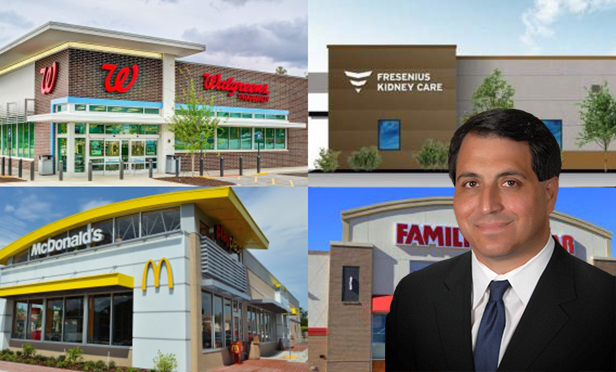 Randy Blankstein, president and founder, The Boulder Group, Wilmette, IL
Randy Blankstein, president and founder, The Boulder Group, Wilmette, IL
WILMETTE, IL—After three successive quarterly increases, retail net lease cap rates were flat in 4Q 2018, ending the year at 6.25 percent, according to a new report from Wilmette, IL-based The Boulder Group.
“As the Federal Reserve continues to implement its monetary policy there is investor expectation that cap rates should trend upward in 2019,” says Randy Blankstein, president and founder, The Boulder Group. “The majority of property owners believe we are in the last stages of the current real estate cycle.”
While cap rates for retail properties were flat in the fourth quarter, in Boulder Group's research, retail cap rates increased 18 basis points for the year. Cap rates for office properties were essentially unchanged for the year with a nominal, two bps increase in the fourth quarter, to 7.02 percent. Industrial net lease cap rates were the only ones to decline for the year (16 bps) despite a five-bps increase in the fourth quarter.
The increase in cap rates during 2018 is indicative of what The Boulder Group and its clients expect to see in 2019.
In the firm's recent national survey, most active net lease participants—approximately 95%—expect cap rates to rise in 2019. Nearly half of those responding, 48%, predict cap rates will increase between 25 and 49 basis points by the end of 2019. One third of participants expect the increase in cap rates will range between one and 24 basis points by the end of the year. None of the participants expect cap rate compression.
“Investors will carefully monitor the capital markets and the effect on pricing as more rate hikes are expected from the Federal Reserve in 2019,” says Blankstein.
One of the benchmarks of the net lease market is the level of new offerings being added to the market. In the fourth quarter of 2018, the net lease sector experienced an increase in supply of approximately seven percent, based on a 9.63% increase in the number of retail properties now being offered.
According to Blankstein, property owners are supplying the current market with their non-core net lease holdings in order to take advantage of the historically low cap rate environment.
For the quarter and for the year, the supply of office and industrial net lease property listings decreased.
“Ahead of these increases in the supply of net lease properties for sale, the net lease market strongly favored sellers in recent years,” Blankstein says. “However, the market has shifted into more of a neutral position.”
In tandem with the increase in the number of properties being brought to market, in the fourth quarter of 2018, the spread between asking and closed cap rates was 31 basis points, the largest spread since the second quarter of 2017. Additionally, the spread for short term leased properties with non-investment grade tenants was even greater (51 basis points) in the fourth quarter of 2018.
“Investors who are willing to take on the risk of shorter-term leases have been able to take advantage of this shift,” Blankstein says. “Properties with short term leases and without investment grade tenants or strong residual real estate had the greatest change in cap rates in the current rising rate environment.”
The recent volatility in the stock market and other alternative investments, bodes well for net lease assets which continue to be perceived as safe and secure investment options. Accordingly, they are still commanding historically low cap rates. The most attractive of these assets, with the lowest cap rates in the sector, are newly constructed properties for strong credit tenants.
In looking ahead to 2019, Blankstein says investor demand for the net lease assets remains strong and the net lease market is expected to remain active in 2019, even if activity levels are flat or slightly lower than the historic levels of activity for the last several years. However, along with an active market, the projection is that there will likely be upward movement in cap rates moving forward.
National Asking Cap Rates
| Q4 '17 | Q1 '18 | Q2 '18 | Q3 '18 | Q4 '18 | QBps Chg | YoY bps chg | |
| Retail | 6.07% | 6.10% | 6.20% | 6.25% | 6.25% | 0 | +18 |
| Office | 7.00% | 7.00% | 6.95% | 7.00% | 7.02% | +2 | +2 |
| Industrial | 7.25% | 7.29% | 7.04% | 7.02% | 7.07% | +5 | -18 |
Recommended For You
© Touchpoint Markets, All Rights Reserved. Request academic re-use from www.copyright.com. All other uses, submit a request to [email protected]. For more inforrmation visit Asset & Logo Licensing.







